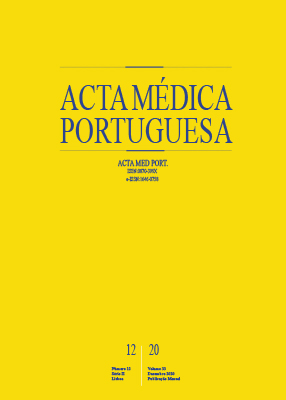ECMO in Neonates with Congenital Diaphragmatic Hernia: The Experience of a Portuguese ECMO Referral Center
DOI:
https://doi.org/10.20344/amp.13075Keywords:
Extracorporeal Membrane Oxygenation, Hernias, Diaphragmatic, Congenital, Infant, Newborn, PortugalAbstract
Introduction: The use of extracorporeal membrane oxygenation (ECMO) is considered by many authors as one of the most important technological advances in the care of newborns with congenital diaphragmatic hernia. The main objective of this study was to report the experience of a Portuguese ECMO center in the treatment of congenital diaphragmatic hernia.
Material and Methods: Descriptive retrospective study of newborns with congenital diaphragmatic hernia requiring ECMO support in a Pediatric Intensive Care Unit from January 2012 to December 2019. Data collection using the Extracorporeal Life Support Organization registration and unit data base.
Results: Fourteen newborns were included, all with left congenital diaphragmatic hernia, in a total of 15 venoarterial ECMO cycles. The median gestational age was 38 weeks and the median birth weight was 2.950 kg. Surgical repair was performed before entry into ECMO in six, during in seven and after in one newborn. The average age at placement was 3.3 days and the median cycle duration was 16 days. Prior to ECMO, all newborns had severe hypoxemia and acidosis despite optimized ventilatory support, with nitric oxide and inotropic therapy. After 24 hours on ECMO, there was correction of acidosis, improvement of oxygenation and hemodynamic stability. All cycles presented mechanical complications, the most frequent being the presence of clots in the circuit. The most frequent physiological complications were hemorrhagic and embolic (three newborns suffered an ischemic stroke during the cycle). Five newborns (35.7%) died, all associated with complications (two strokes, two massive bleedings and one accidental decannulation). Chronic lung disease, poor weight gain and psychomotor developmental delay were the most frequent long-term morbidities.
Discussion: Despite technological advances in respiratory care and improved safety of the ECMO technique, the management of these newborns is complex and there are still several open questions, including the appropriate selection of patients, the best approach and time for surgical correction, and the treatment of pulmonary hypertension in the presence of persistent fetal shunts.
Conclusion: Survival rate was higher than reported in 2017 Extracorporeal Life Support Organization report (64% versus 50%). Mechanical and hemorrhagic complications were very frequent.
Downloads
Downloads
Published
How to Cite
Issue
Section
License
All the articles published in the AMP are open access and comply with the requirements of funding agencies or academic institutions. The AMP is governed by the terms of the Creative Commons ‘Attribution – Non-Commercial Use - (CC-BY-NC)’ license, regarding the use by third parties.
It is the author’s responsibility to obtain approval for the reproduction of figures, tables, etc. from other publications.
Upon acceptance of an article for publication, the authors will be asked to complete the ICMJE “Copyright Liability and Copyright Sharing Statement “(http://www.actamedicaportuguesa.com/info/AMP-NormasPublicacao.pdf) and the “Declaration of Potential Conflicts of Interest” (http:// www.icmje.org/conflicts-of-interest). An e-mail will be sent to the corresponding author to acknowledge receipt of the manuscript.
After publication, the authors are authorised to make their articles available in repositories of their institutions of origin, as long as they always mention where they were published and according to the Creative Commons license.









